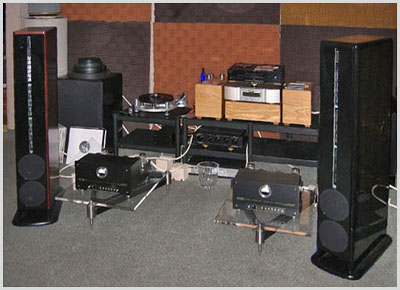|

comments from
CES 2006
on VMPS RM30 C + Original
Subwoofers system
(all
comments are linked to original pages where they
appeared)

Roger Gordon
for www.positive-feedback.com
"VMPS / Bruce Moore - VMPS was demoing their RM-30C loudspeakers with the new constant directivity waveguide. The waveguide replaces the usual grill cloth with a solid covering over the tweeter and the three ribbon midrange drivers. The covering has a slot cut down the middle that is 2/3rds of an inch wide. The slot serves as a diffraction grating that turns the midrange drivers and tweeter from point sources into line sources. Line sources radiate in a 180 degree dispersion pattern―hence the term constant directivity. The advantage of constant directivity is that there no longer is a sweet spot. The sound is essentially the same anywhere in front of the speakers. This is a big claim that I was most anxious to test seeing as I own a pair of RM30M loudspeakers. I tested the claim by moving around the room while playing a number of my CDs. The constant directivity waveguides worked as claimed. Until you went behind the plane formed by the front of the two loudspeakers the sound was essential the same regardless of your position. No more sweet spot. Amazing. The Bruce Moore tube electronics mated very well with the VMPS speakers.
In fact, to my ears, this is the best the VMPS room has ever sounded and that includes the two years when they won Best of Show at CES in 2002 and 2003."
Dave
& Carol
Clark for www.positive-feedback.com
"The VMPS/Xtreme Cable/Bruce Moore room was very nice. Big and powerful with pin-point imaging and a very natural sense of tonality."
Frank Alles for www.stereotimes.com
"The third bang for the buck system I happened upon was in the VMPS/Bruce Moore suite, in ST1303. We heard the RM30C speakers ($3700), which use VMPSís new, patent-pending Constant Directivity Wave Guide technology. The wave guide appears to be a thick acrylic plate with heavy damping material on the back, which covers the midrange ribbons except for a 0.667-inch aperture that runs down the center of the midrange driver array. This technique is responsible for allowing 180-degree high frequency dispersion, resulting in a very even frequency balance along the lateral plane. It greatly improves off-center, out of the sweet spot listening, to which I can attest. Bruce Moore 225-watt mono tube amplifiers ($15k) were employed to drive the RM30Cís, and two VMPS Original subwoofers ($499 ea.) filled in the bottom octave bass.
The sound was dynamic, natural, and clean; and was comparable to the price-no-object systems at the
show."
Dick Olsher for www.enjoythemusic.com
"The VMPS RM-30 speaker, driven by Bruce Moore
amplification, made a lasting impression. It
features a ribbon midrange (three panels)
operating from about 280Hz up to 7kHz, and a
narrow ribbon tweeter operating to beyond 20kHz.
Several woofers handle the bass octaves. Another
key feature is a Constant Directivity Wave Guide
(patent pending) incorporating a damped,
0.66-inch aperture or "diffraction
slot" that takes advantage of the fact that
large ribbons act more like plucked strings than
pistons with most the acoustic output being
generated from the center of the ribbon. About
75 percent of the diaphragm is masked off (with
suitable absorption to prevent a lot of sound
energy being reflected back into the diaphragm),
leaving the 2/3-inch wide center section to
generate output. The tweeter is already narrower
than 0.66-inch, so it is fitted with its own
waveguide that slightly widens it acoustically.
The result is said to be a true line source,
two-thirds of an inch wide from 280Hz up with
180 degrees of dispersion. I can testify that
while sitting in the back of the room, more or
less in line with the left channel, I was still
able to perceive a reasonable soundstage."
|